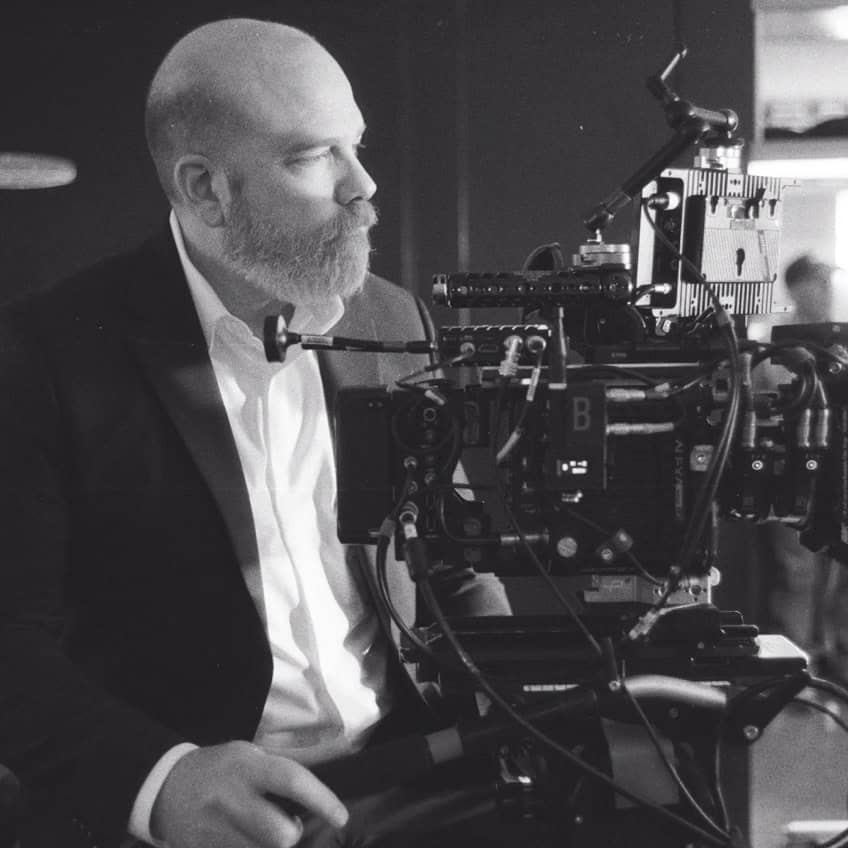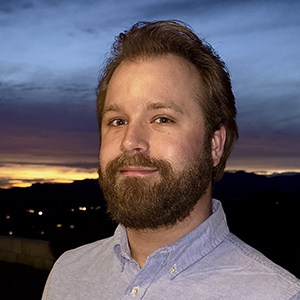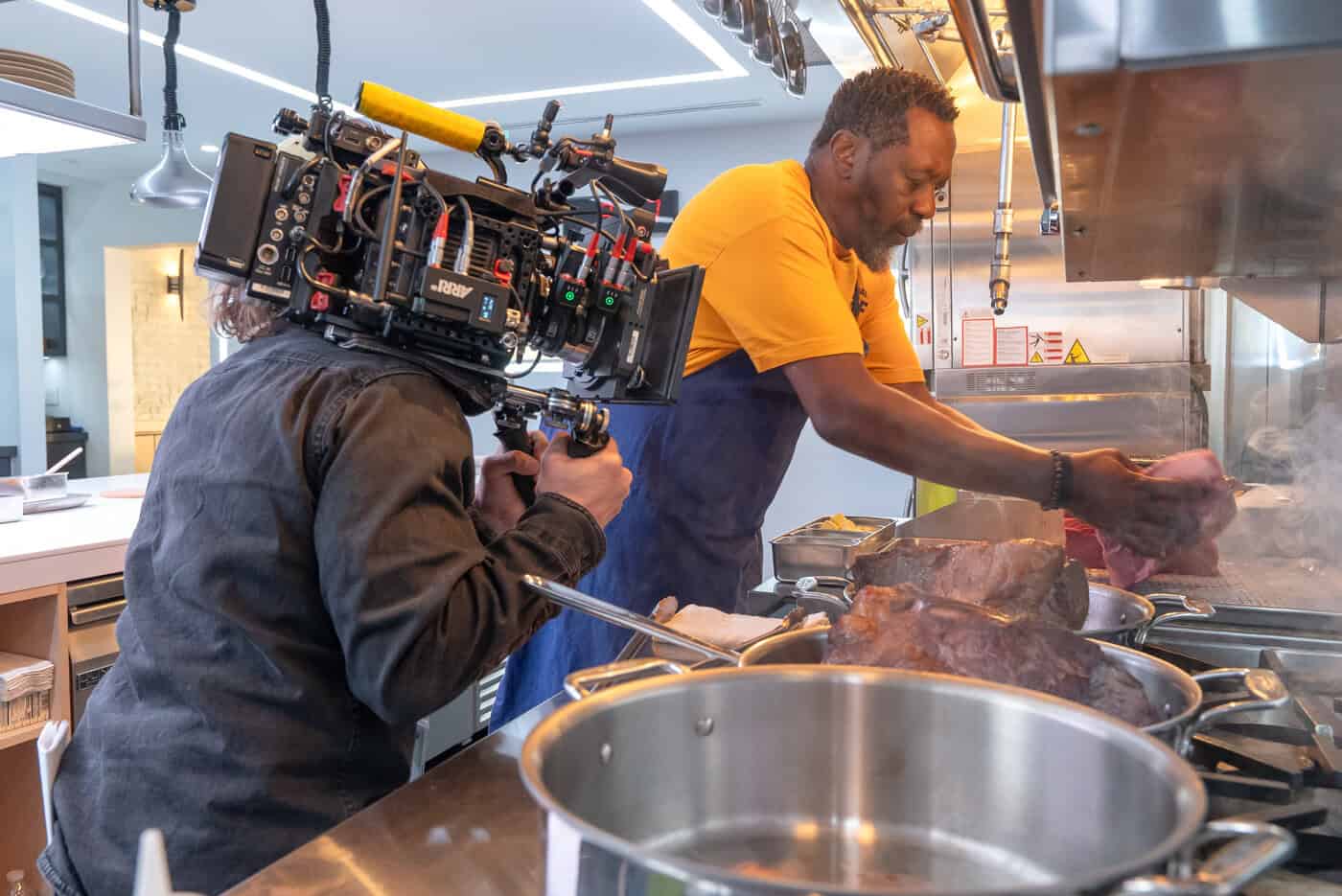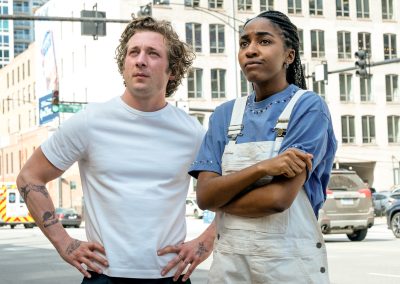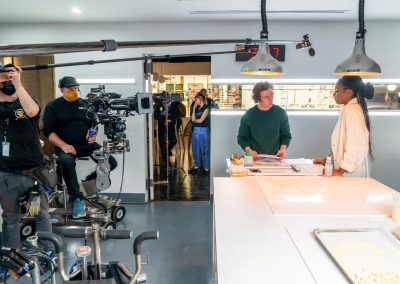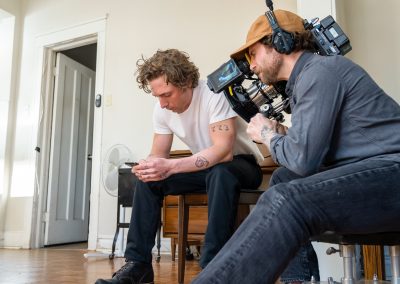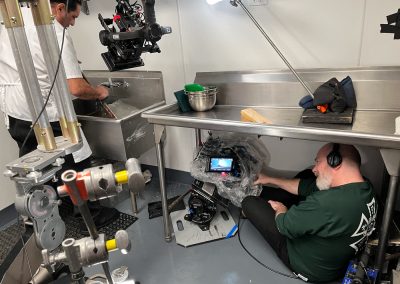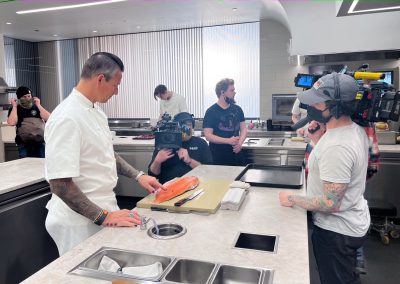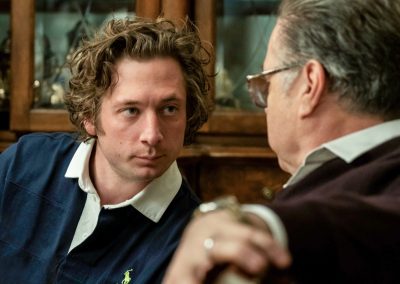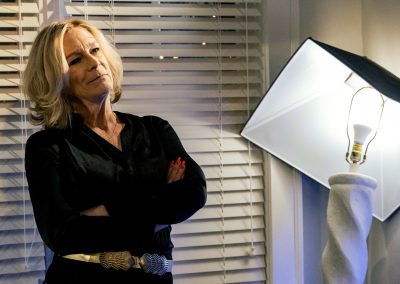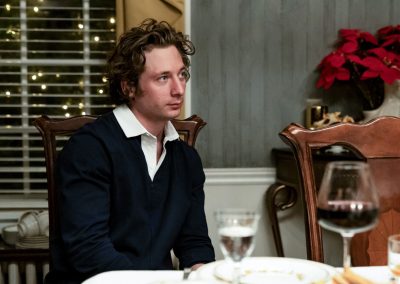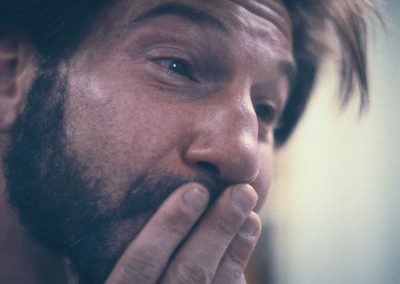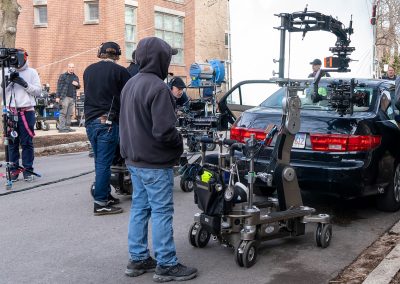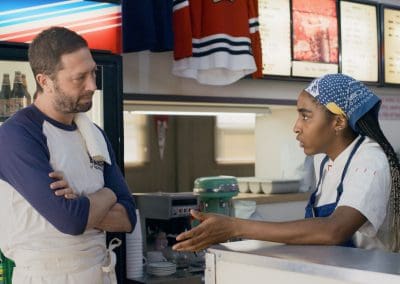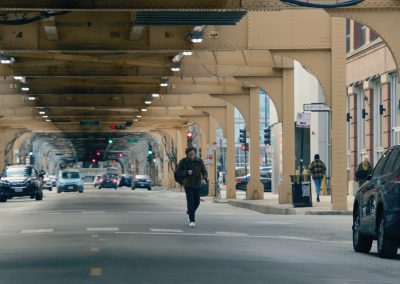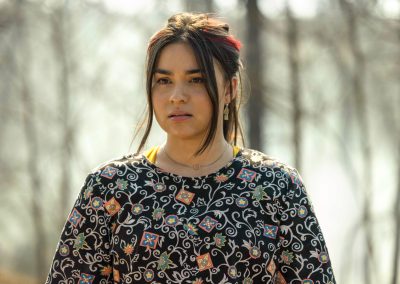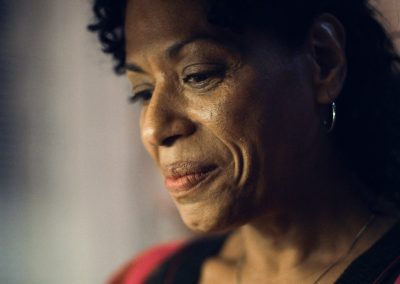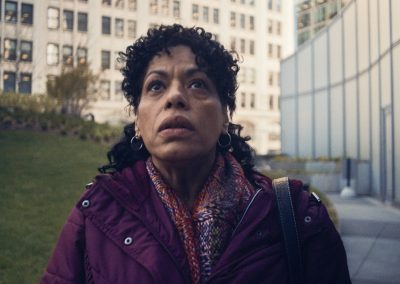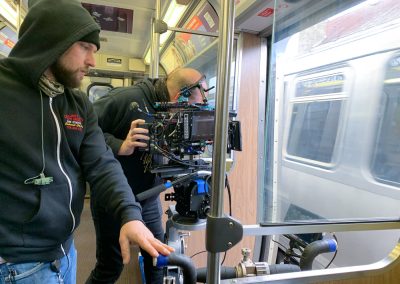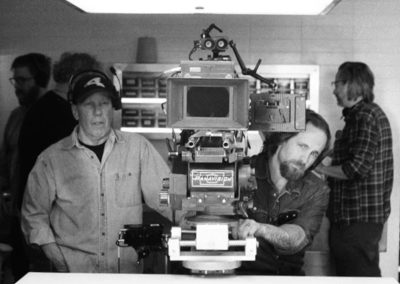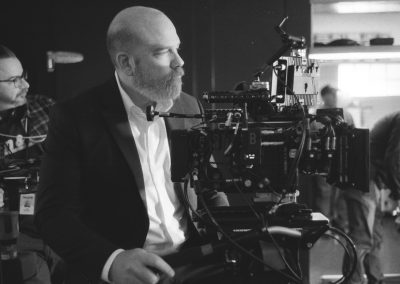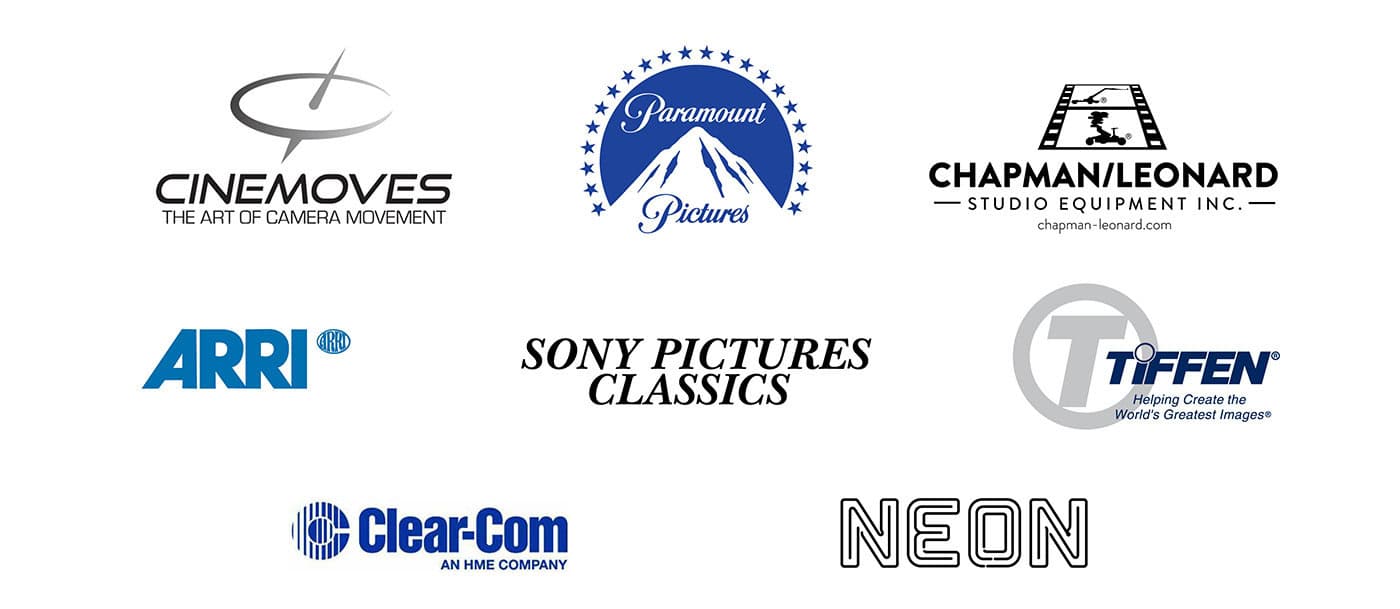The Bear
Every Second Counts
A Conversation with Gary Malouf & Chris Dame
By David Daut
Despite being categorized as a “comedy series” for the purposes of awards by the Academy of Television Arts and Sciences, watching The Bear can often feel like having a panic attack. Between stellar performances from the series’ principal cast, bold direction, and ambitious camera work, the visceral thrill and white-knuckle terror of working in a busy kitchen during the dinner rush breaks through the barrier of the screen and pulls you in.
Now in its third season, the critically acclaimed, award-winning series continues to innovate and push its visual style in new directions. Camera Operator had an opportunity to speak with A camera operator Gary Malouf and B camera operator Chris Dame about their experience working on the show from the beginning, from having the trust and freedom to be truly collaborative in the shooting of each episode to breaking down the process behind pulling off a 17-minute oner in only three takes.
After inheriting a cash-strapped roast beef sandwich shop from his deceased brother, Carmy Berzatto dreams of transforming The Beef into a Michelin-starred fine dining establishment. The process of doing so, however, is far from straightforward. With debt and deadlines looming large, Carmy’s personal demons take their toll as he wrestles with how much personal happiness has to be sacrificed in the pursuit of professional success. The Bear is created by Christopher Storer and stars Jeremy Allen White, Ebon Moss-Bacharach, Ayo Edebiri, Lionel Boyce, Liza Colón-Zayas, Abby Elliott, and Matty Matheson.
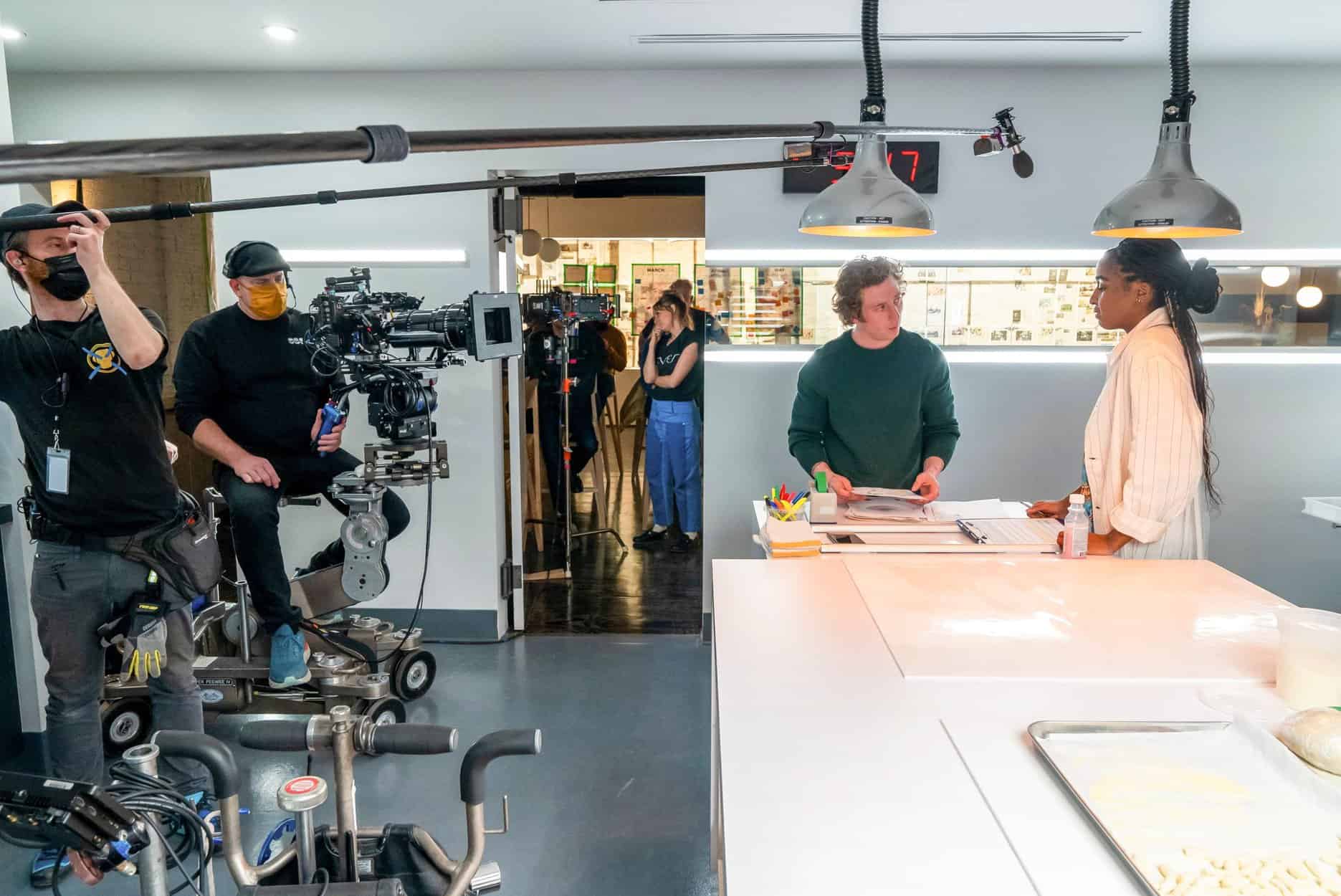
Camera Operator: To start things off, I’m interested in how you both initially got hired onto the series. Gary, I know you had previous connections with Christopher Storer and Andrew Wehde, but could you talk a little bit about how you were both approached to be on the show, and how that developed?
Gary Malouf: I go way back with Chris and Drew. We’ve known each other for probably about 15 years now—we did an initial job way back when. It was a documentary about the Thomas Keller Restaurant Group, so it’s kind of come full circle for us to have come back into the culinary world. I had read the script for The Bear a long time ago when it was supposed to be a movie. As things tend to happen, it turned into a TV show, and Chris finally got it off the ground. He called me up for the pilot, and I was available. Drew, however, was not available, so Adam Newport-Berra did a wonderful job shooting the pilot, then Drew came in when it went to series. When we were looking for a B camera operator, Chris [Dame] was one of the first names that came up, and luckily for us, he was interested. It was really that simple. It was just trying to find a group of people who we trusted their talents and wanted to work with. I think too that we all had a background in being fans of restaurants, so it made sense for all of us to come together and do this thing. At least that’s how I remember it.
Chris Dame: Sounds right. I met Drew about 10 years ago, and he was kind of picking my brain over tech stuff when I was a camera assistant. So, we first connected on how to pull focus on the slider, what kind of focus systems we preferred, and now that’s evolved into geeking out over lenses. Then, I was lucky enough to work with a Storer on a comedy special a couple months before The Bear. I usually don’t go out after shooting, and Chris is the same way, but one night we both ended up at a bar, drinking, and talking about restaurants. That was where I first realized, “Oh, this guy’s cool.” So, certainly hearing his name attached to this—as well as Gary and Drew—it was a no-brainer. That’s how it started for me.
CO: You’ve both been on the series since the very beginning, and with each new season, I feel like the show has shifted and expanded its visual language. Can you talk about what it’s been like to work on the series as it sort of constantly reinvents itself?
Malouf: For me, I think we’re always just trying to tell the story. Not only in the way Chris [Storer] wants to tell it, but also in an economical way where less is more. You get thrown into this world where you’re not shown too much, but shown just enough to get you interested and pull you in. There are certain things that Chris never explains. All of these culinary terms get thrown out, and nobody ever expands on them. That was how I thought of it from a camera perspective as well. How can we show as much as possible with the least amount of coverage?
We don’t need to hear every line. If the coverage that we’ve decided for the master works as one, that’s okay. That’s how it started—at least in the first season—as we were kind of finding that visual language and really settling into the way that the show was going to look. Then as the show evolved, like the characters and like the restaurant itself, you mature and you try to do things a little bit differently, a little bit better. I think we matured as filmmakers, matured as storytellers, and everything just kind of fell into place in that weird way. And obviously the writing and the acting is so tremendous that they really do lead us in a lot of ways. So, there wasn’t necessarily much discussion about what the show should look like, it was more what feels right in the moment. How can we connect to this story right now and lean into that? And hopefully have people connect the same way.
Dame: I absolutely agree. We don’t beat it up. I think the best thing about it is that you don’t really talk about it. Because there’s this trust, you can just stay zeroed out and ready and present for whatever’s coming, and let the story dictate what it should be.
I remember back on Season 1, I’m sure Gary and Drew had discussed the look of the show beforehand, but I was not privy to any of those conversations. We just started shooting it, and I was just racing around on a dolly, zooming in and doing all this stuff. I remember going to Gary on day two or three, and I said, “So, I’m kind of here, here, here, and everywhere, doing all this shit.” And he’s like, “Cool. So am I.”
I think Gary and I have very similar instincts as far as what has been given to us, and also when to just let it go. So then in Season 2, we’re showing off The Bear—the lines and the color and the shape that Drew gave us—and the gaffer gave us the freedom of shooting everything. For the season, Storer gave us one word: elegant. And we went with that. Reading the script, you visually see what it should be, and then the actors and the culinary team give you these indicators of what the shape should be as long as you’re staying completely open and present to what it might be in that scene. One thing that I appreciate is the challenge of not asking the questions and not breaking it down, to just be ready for it to reveal itself, to show what it’s supposed to be, and be there with Gary, and always be watching as the B camera guy. Always be watching the monitors. Always. Even if I’m not working, I’m constantly there, still watching what’s happening to see where it’s going, how it’s evolving, and what we need.
Malouf: I think a lot of it has to do with the fact that I had such a shorthand with Drew and Chris going in, that we kind of already knew how to say a lot to each other without saying much. I know when I need to be flying around on a dolly and on a zoom lens and fighting for overs and doing that stuff with Chris [Dame] out of the way, and I know there’s other times where this is a super-designed, slow push-in on a moment and I just need to let these actors cook, just be that fly on the wall. I’ve always heard people say great camera operating is invisible, and for me, it was like the mantra for the show. No move should ever be unmotivated. No move should feel like it was anything other than trying to tell the story or trying to keep up with the chaos, which—especially in Season 1—is telling the story, because you’re thrown into this wild environment. You can only imagine what it’s like actually cooking in a real kitchen. So, for us, it was almost like riding the wave, trying to hang on, and just making sure that we’re always ready and always prepared to shoot whenever something happens. To find those textures that the actors are so good at bringing. Jeremy [Allen White] would just be waiting to go while they reset all the food, but he’d keep tapping that spoon like crazy—someone shoot that. We were constantly trying to find these little details that could help build the world around us without ever feeling like we were in anybody’s way.
Dame: Or define it. We didn’t have to break it down.
Malouf: I had always been a fan of culinary culture and restaurants in general, but I never realized how much we had in common with them. The fact that we’re in this space together with each other all the time, and every second counts; everybody’s got to be ready, we have to be able to count on each other, and we have to be ready when it’s our time to perform. We also have to keep our mental health as well as our physical health in mind, and always be taking care of one another. Once we started working with these chefs like Matty [Matheson]—who’s obviously a character on the show, but is also a culinary producer—and Chris Storer’s sister, Courtney, is one of the culinary producers; just letting them drive where we were going to go, because they knew all the details that make it real. “Oh, you would never do this over here, you would do it over there.” Just let them drive it, and then we would be there to polish it visually.
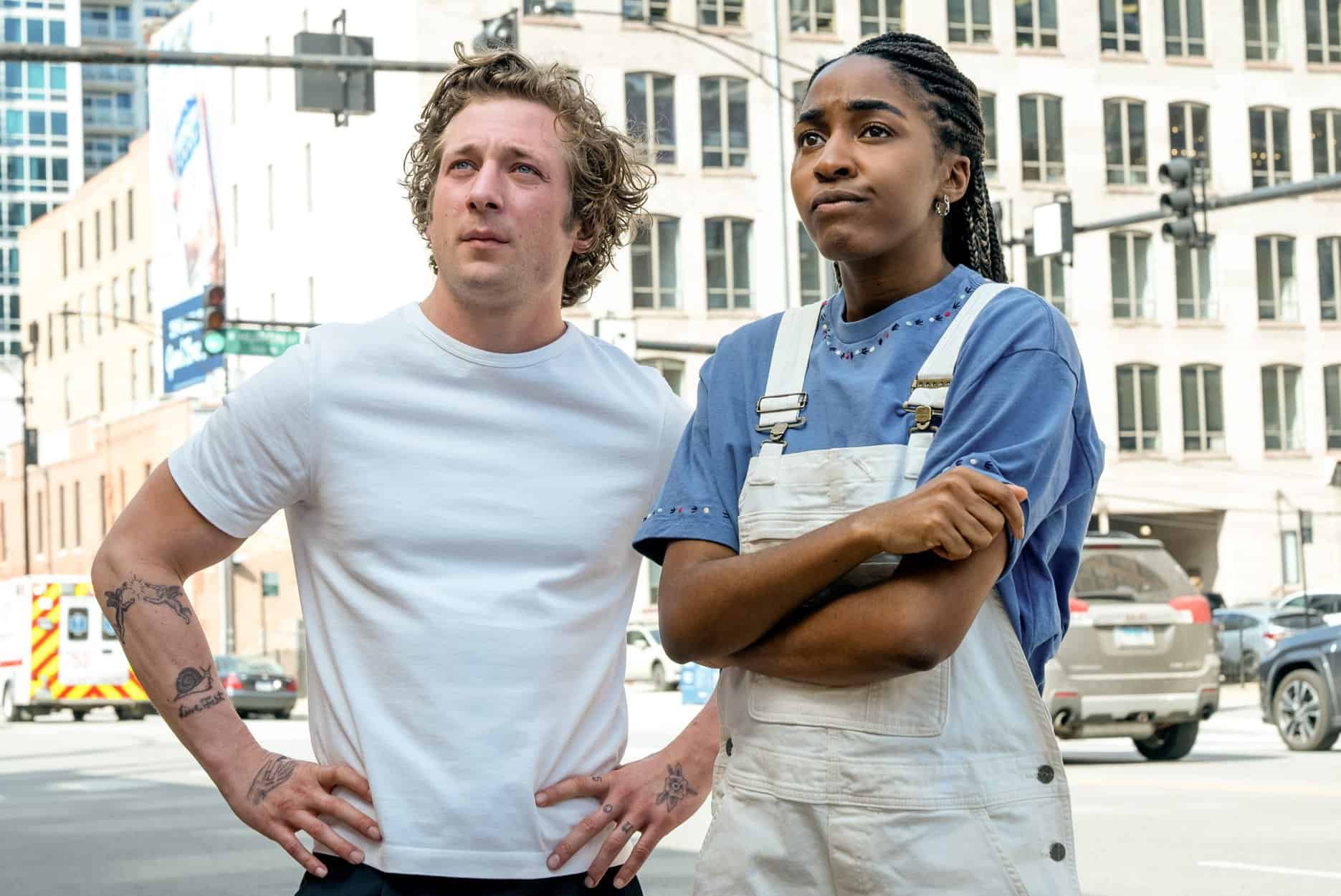
CO: I think that’s a really interesting insight; the way the experience of working on the show dovetails with the subject of the show itself. Having worked with Storer and Wehde previously, you talked a little bit about the shorthand you had already established with them. Going into this, having those relationships already established, how would you say those relationships have grown and evolved over your time working on the show?
Malouf: I think in a lot of ways they’re just stronger. I always joke that Chris [Storer] is one of those guys who would have been great no matter what he chose to do, he just happened to do this. But he could have been Phil Jackson; that’s how I feel about him. He is this incredible leader, and the kind of guy that is so prepared. He comes in, and he knows what he wants, he’s done all the work, and he’s so ready that it just puts everybody on notice that you had better bring your A game. I love you guys and I trust you guys, but you gotta keep up. I think that kind of environment really allowed people to have the pressure taken off of them in a way, because they just had no choice but to do it. Just to be ready. That went for every department, whether it was a focus puller or a props person or anybody in between. We’re not going to hold anything up for anything other than a natural disaster. At least for me personally, I was put in a position where I had no choice but to trust myself, trust my decisions, trust the actors, trust my dolly grip, trust my focus puller, trust Drew and Jeremy Long—our gaffer—and trust everybody, because we’re probably only going to get one or two chances at this. He bred that environment and that culture. We really became a bit of a family because of it. I know it sounds corny, but that was the environment for sure. I always felt that way about Chris and Drew specifically, but I think they brought what we had together as old friends, and really expanded to everybody else on the crew.
Dame: With Gary, right out of the gate, I had respect for him. I’d known him for a long time, and it’s just built over the years, the trust and respect. It’s that thing where you can just be present and be ready. I know that we all have each other’s back in camera all day long. It’s just talented people being brought together. Whoever orchestrated it, if you want to say it was Drew or Chris, or whoever put us all in that situation.
The trust and respect is the huge part. Every department gets to be in that moment to deliver it. Instead of being fearful or overthinking it, we really just get to savor it. In those moments, it’s happening, and then they call cut, and we try a bite of the food or talk about the dish; it’s not, “Did we get it or not?” You look to Chris, and I don’t think he’s ever really said we didn’t get that, or we missed this beat. He’ll be very specific about what he needs if he needs to be, but otherwise he doesn’t really say much, and we just get to go with it.
Malouf: Chris is one of those guys that’s very conscious of what he wants, but it’s more in tone and more in how it feels. He’s not so caught up on technical perfection. “That performance was great, you were where you needed to be when you needed to be there, and that felt right. Moving on.” Don’t overthink. If it feels right, it’s right.
Dame: And we feel the same way. I’m not going, “Oh, this is short, or that was that.” It’s did that feel right? Did we do that for what it was?
Malouf: I think that there’s also a bit of embracing the imperfections. Stuff that from a technical, camera operating standpoint, I might say, “I would really love another chance at that.” and Chris would say, “No, it’s perfect. Great.” Then you watch it in dailies, and you realize, oh yeah, I couldn’t see what he saw, because I’m too in my head trying to do a good job executing the shot. But the take I thought was perfect didn’t have the right feeling or emotion. I was too close to it to see that.
The other part of it that’s really exciting for me is that Chris is very precious in prep, but not precious in production. That allows everybody else to have a little bit of ownership. On so many sets, you feel like you’re just a number; you’re just there to go from point A to point B, and someone goes, “Hey, good job. See you tomorrow,” and that’s it. But, I think a lot of people on our crew—especially in camera—really felt an ownership over every single thing that they contributed. Not only do you have that kind of pride, but you also have that attention to detail. This is my shot, I’m in it 100%.
Anyone could walk up to an actor and ask how they’re going to do a take—not to question or challenge their decisions, but just so that they know because they don’t want to miss it. I want to make sure that I’m ready, I’m here, and I’m present with them. I’m watching them and working with all the chefs and all the culinary experts that are there so that I know where to put the camera. And Chris is very protective of performance. His belief is don’t make them keep doing it, because it’s only going to get worse in a lot of ways. In most cases, they’re going to nail it right away, because they’re so prepared. Everybody’s so prepared, so you’d better be prepared as well. It becomes this abstract thing for us, because we come from a world where you get a second team rehearsal, and then you get a first team rehearsal, and then we shoot. Here it was just, “That’s it, moving on.” Before you even had a chance to say anything, he’s in the other room setting up the next shot. You just don’t have time to question it.
Dame: I don’t think the second ACs ever wrote a “four” on the slate. It was almost always either one or two. You can feel it when you’re watching it and you’re shooting it. It’s there. I’ve worked on a bunch of different shows, but never anything like this. It breaks all the conventions.
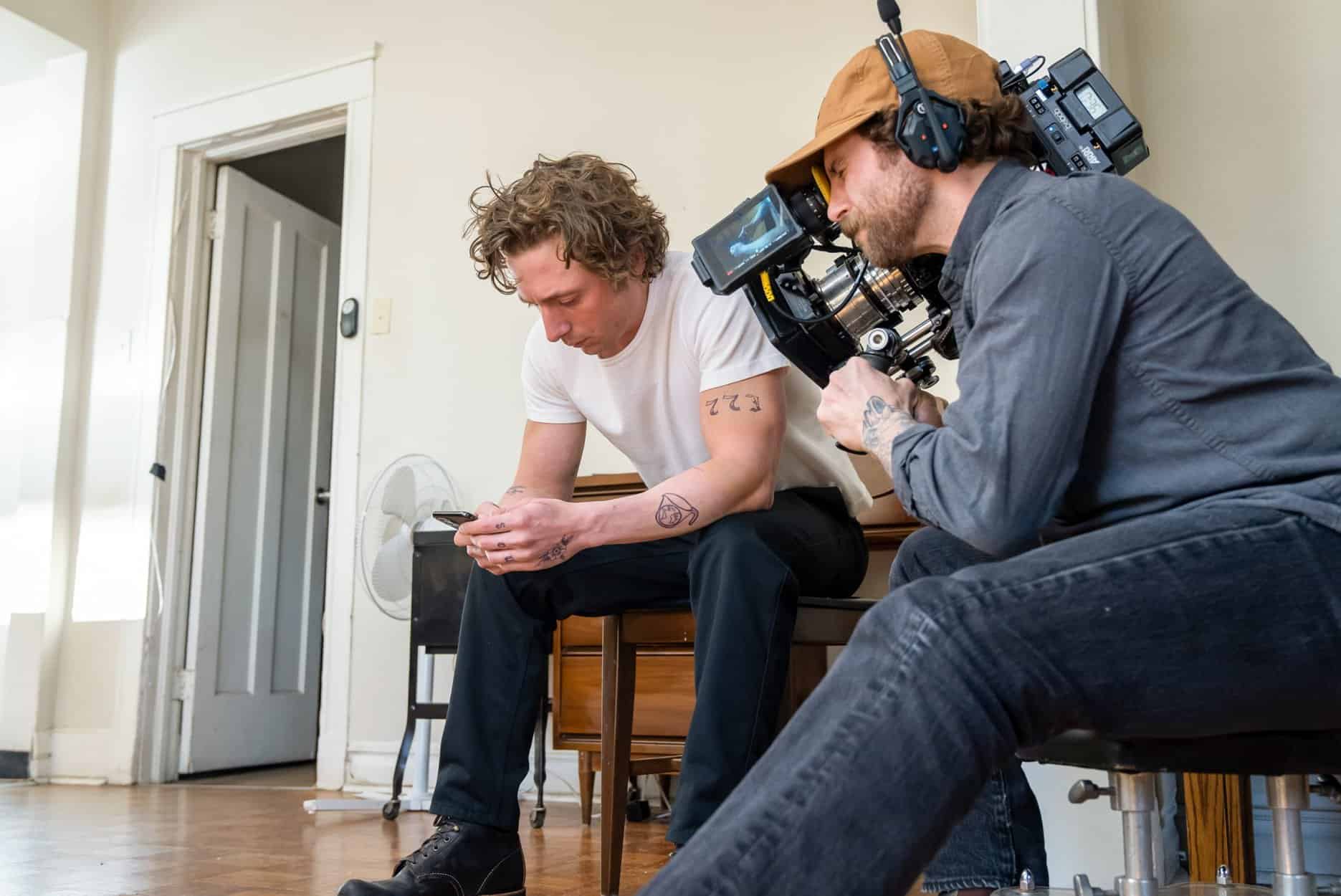
CO: We’ve talked about the high-level style of the show and finding that visual language. It sounds like a lot of that developed very organically through trust in each other, and trust in the end product. Each season it seems like there’s at least one episode that sort of deliberately sets itself apart from the rest of the series. In Season 1, Episode 7 was presented as a single take. You have the flashback episode in Season 2, “Fishes.” There were a couple like that in Season 3 as well. Were those any different in how you approached them from the rest of the series, or was it still very much that sort of organic, find-it-as-you-go process?
Dame: Gary broke the rules, man. You’re not supposed to be able to do that kind of oner in five takes. I can’t remember the actual page count on it, but it was 17 minutes. It should have been a week’s worth of work, and we were done before lunch. It was another one of those things where the studio was like, “How did you do it?” A lot of people come up and ask, “How did you do this?” On the last job I was on, the director right away said, “I need to talk to you at the end of this job.” She came up to me, and she said, “All right, so you had 16 characters around the pass. How’d you do it?” And I showed her the arc and the camera lines and all of that stuff, and it looked psychotic, but that’s how we did it.
We did that in three takes, and there was all the coverage, and if I was going to see Gary, I would go down to a piece of the details, and if Gary was going to see me, I just ducked down. We didn’t even discuss that. It was just feel it, do it. My part on the oner goes back to being present, being a part of it. I wanted to be supportive. What he did—and he’s done it so many times on this show—is deal with the camera for, like, half-hour takes. The last thing we did on Season 4–
Malouf: Without giving it away. No spoilers!
Dame: Yeah, we won’t talk about the subject matter, but it was two people on dollies, we had an extra camera, and Gary was doing handheld. It was a half-hour take, and I think we did seven different varieties of that, which was unusual.
Malouf: Yeah, I went about two-and-a-half to three hours straight.
Dame: Insane. Nobody does that. It’s just not done.
Malouf: Probably because nobody’s dumb enough to do it.
Dame: He says yes! Plus Chris knows he can do it. He pushes these oners. But for me, I made sure that I was there, watching every detail of that take to try and help Gary, Drew, J. Lo [Jeremy Long], the lighting, the gaffer and Matt Rozek, the focus puller, to look and see if I could contribute and be there for that shot as it evolved. That was that one. And then “Fishes” was absolutely gonzo.
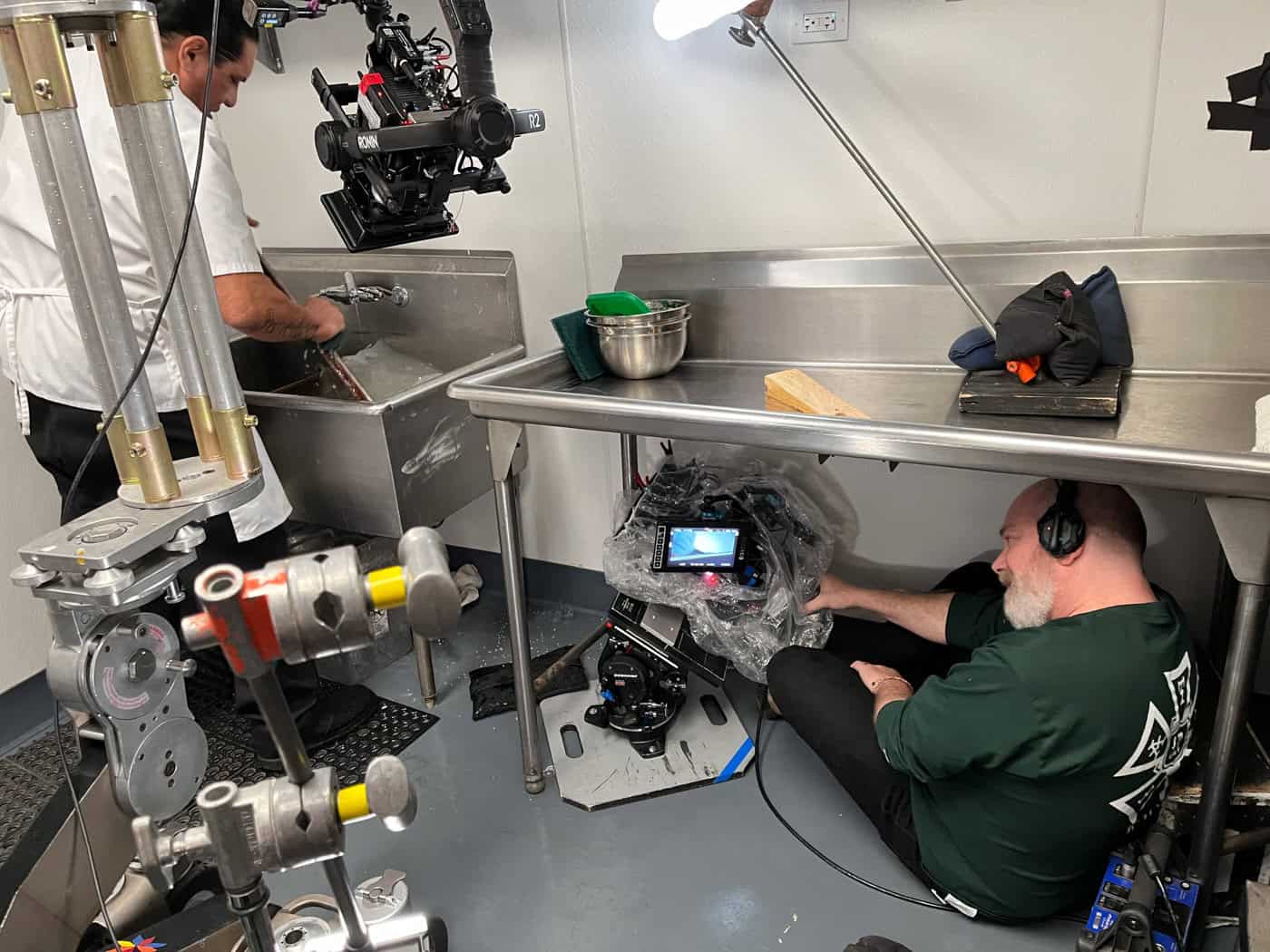
Malouf: To touch on those two episodes specifically for the purpose of this discussion, a lot of it has to do with Chris [Storer] just not really caring too much about the rules of television. I think he looked at it a little bit more cinematically. He had a different perspective on what TV can be and what you can do in 20 minutes to tell a story, trusting the people that he put into place to run with it and trust each other and just go for it.
With that first oner, I think we ultimately stumbled on that it’s like theater. We don’t cut, and even though everybody is not always on camera, they’re still acting, they’re still paying attention, they’re still being present. Then, all of a sudden, you’re hitting your marks and hitting your cues like you would on a stage in theater, and I think for the actors, especially, that was something very exciting for them. Because of the choppy nature of filming, typically they’re in a performance for just a short period of time, then someone calls cut and everything stops until the red light goes back on. But in these moments, they got to be in it the whole time and really stay there. I think they really appreciated that, because it’s something that’s so rare for them.
And for us, it was really freeing in the sense that now we’re getting to make creative choices on the fly. We did rehearse it, and we did work it out, but at the same time, there are certain points where the unexpected happens. Maybe this person beat me to a spot, and now I have to make it look like I was supposed to do that and know that my focus puller, Matt Rozek, will be with me even though he’s not expecting it. Meanwhile, you’d have Chris [Storer] and all the other people at the monitor watching us do all these things, saying, “That part was different, but it was better.” Okay, great. Well, I’m going to do that again. It really got refined in real time, much in the way that you would refine a stage play. It was just this different kind of lane that you normally don’t get in most narrative stuff on a set. It was really freeing for us. You’re so present in that performance and in that story that all the stuff in the back of your head goes out the window. I don’t have time to worry about framing and all that stuff, you just have to trust that you’re going to get there and that it’ll work.
And I think we brought that exact same thing to “Fishes,” because with “Fishes”—especially in the kitchen and in the dining room—we just did the whole thing at once. It wasn’t, “Okay, we’re going to do her coverage, we’re going to do his coverage.” It was Chris [Dame] on a long lens outside of the kitchen and me handheld, and we’re just handing off and going crazy. It would have been really easy for us to feel like we were walking on eggshells because of all these really heavy-hitter actors coming in. We feel very responsible for the environment that they’re walking into and the experience they’re going to have. A lot of them are coming in for a few days, or even just a few hours, and we want to make sure that they walk away feeling like it was a good experience, and that they had a place where they could nurture their performance where everybody was there helping them do it. I think that oner in Season 1 really primed us to create that theatrical atmosphere where someone like Jamie Lee Curtis could come in and just go.
Dame: There was a moment where Gary and I were on top of Jeremy and Jamie, just handheld, breathing on their shoulders as they were delivering the most amazing performance in that kitchen.
Malouf: I think that there’s something that’s really fascinating about how once you get thrown into the fire, it’s like we’re all in this together. The hierarchy of a film set gets thrown out the window. It’s no longer Oscar-winning actor and hack camera operator, it’s just two people trying to figure it out together. That was a very exciting thing as a storyteller and filmmaker, and just as somebody who really loves doing what I do. It was different than anything I’ve ever been a part of, and all of that comes through on camera. We did that again with “Ice Chips” in Season 3. We did two takes, and they just went through it. They did 27 pages all at once.
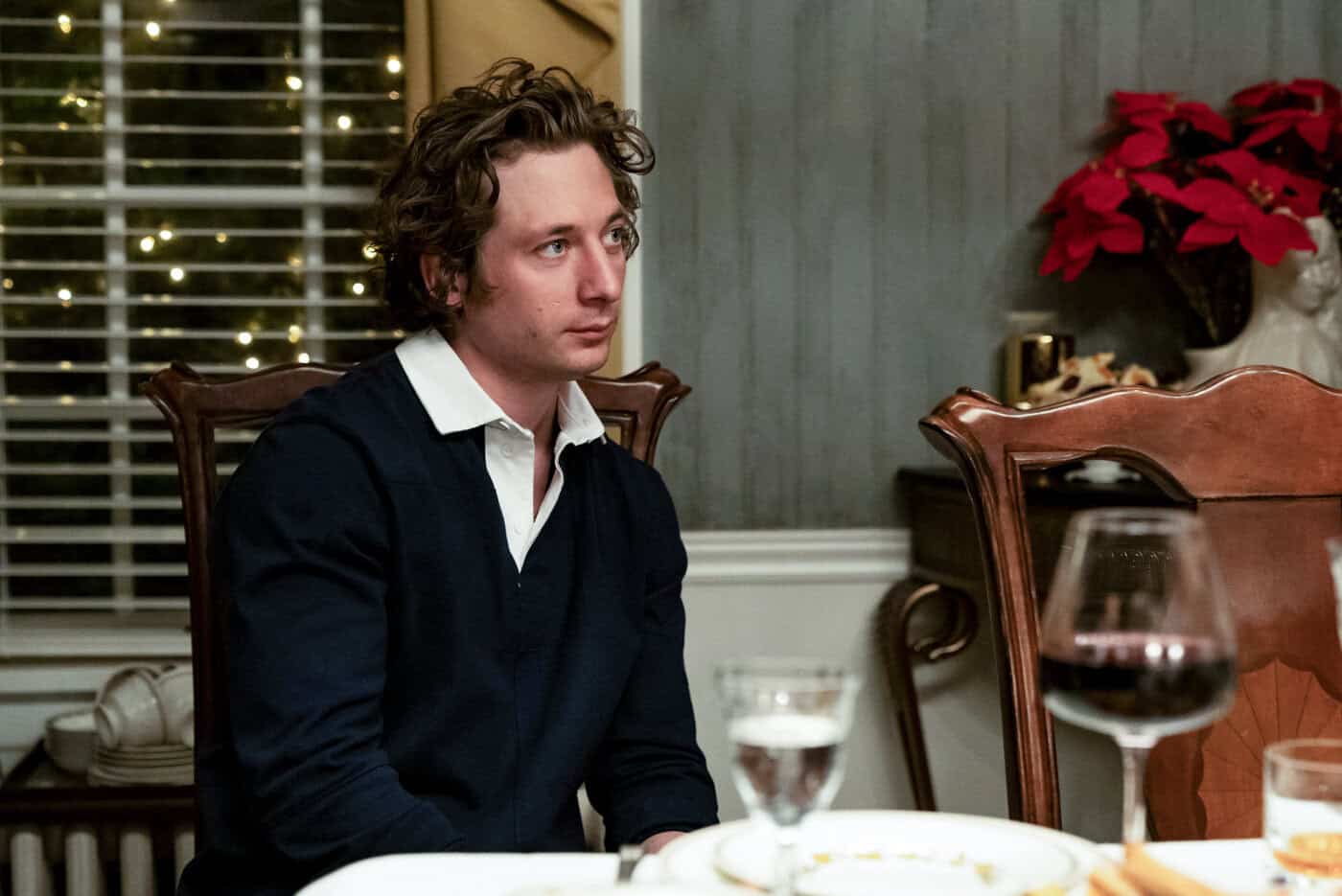
Dame: Twenty-seven pages, four hours. Gary and I—and we had a third camera operator, Mike Penick—just had to work with what Chris had given us. He wanted three cameras and dollies, and that’s it. We had no idea how this was going to work in this tiny, little room, but we trust him, he trusts us, let’s see. Once it started, we figured it out. Meanwhile, Gary’s getting on top of a set piece with his dolly grip slowly moving it out of the way as we’re shooting.
Malouf: Purky [dolly grip Mark Purkart] gracefully moved a nightstand with the dolly.
Dame: We’re just squeezing this thing out and finding the spots and the openings as they’re being revealed to us with these two very talented actors. By the end of it, we’re absolutely exhausted. It’s a 20-minute take and you do three of them. Thank God this is only a five-hour day. But, that’s another way the show totally broke conventions. Twenty-seven pages, four hours, three cameras, three takes. On “Fishes,” the whole time we were at that house, I don’t think we ever went to lunch. Maybe once, but it was almost always six-hour days.
Malouf: Another thing I’ll bring up about “Fishes” to toot Chris’s horn: the inserts in that are so incredible. They really texture that episode in a way where you think, Oh, man, I’ve been in that house. I feel like I can smell the walls.
Dame: I walked into that house, and I was blown away by the detail.
Malouf: And that’s a testament to our set decorators and our production designer, Merje Veski, and everybody that’s involved to create that world for everybody to walk into and breathe and live in. So, while we were working out A camera stuff, Chris was just going around shooting 9,000 inserts. And they really do layer that episode in a way that I don’t think anything else we did camera-wise could have accomplished. Again, it’s that trust of Storer saying, “Dame, just shoot the hell out of this place. You got it.” Never reviewed anything, never had to okay anything. There’s this beautiful montage at the beginning of that episode where you get to see what Chris was up to that whole time.
Dame: When you’re shooting a typical TV show, it’s a 7 a.m. call; everybody gets a pre-call at 6:30, then the shooting call is at 8. So, now you’ve all been there for an hour and a half, and it’s like, what the hell are we doing? What are we waiting on? Why aren’t we shooting this? Chris Storer is the first one there, and he wants to go. This started in Season 1 where I noticed that there’s so much detail here, so many different pieces that have been brought to the table that are part of this bigger thing. Meanwhile, Gary had the Ronin to be able to open up the shots and to orchestrate these beautiful movements. So, it was an opportunity to be able to get into the scene to pepper this stuff in and also alleviate a little bit of the anxiety of Storer to be ready to pull the trigger at call, at seven o’clock. We would have the ADs there, the red light would go on at seven o’clock, and we’ve got the first shot to send off the studio.
So, going back to “Fishes,” walking into that house, I was absolutely blown away. The plastic on the sofa. It was just so thick with detail by all those departments. I had to get in there, and I had this beautiful lens that could get me there. So, I just started doing that with an insert team as Gary, Chris, and Drew were laying out the framework of the scene. And talking about the collaborative aspect, people started coming to me with suggestions. Someone in props would say, “Did you get this? Or, what about this? I was thinking about this—we should shoot that.” And some of it haunted me. There was a picture of Jon Bernthal with his dog that was just so odd I couldn’t stop looking at it. There were parts and pieces of that space that really started embedding itself in my subconscious. I think that’s part of the world that Storer builds. It’s so curious, it has so many layers. “Fishes” was insane.
Gary already mentioned “Ice Chips,” but also Tina’s episode, “Napkins,” stands out to me in Season 3. We also broke conventions there. We went and did her day out on the town, and we worked our way down 18th Street. It looked like this was going to be another mountain, but all the departments did their due diligence and did the right prep on it. We orchestrated this thing that swept down 18th Street, and in six hours we had shown this lady’s experience of hitting the pavement and got to show off Chicago.
Malouf: I would be remiss if I didn’t tout some people that allow us to do that stuff too. The workflow that Drew, J. Lo, and [Thomas] Zimmerman, our DIT, have created is nothing short of amazing. Drew just has this way of really lighting spaces. He’s very talented in just allowing you to go wherever you want. He really does provide this giant sandbox for us to all get in, and we just all turn into little kids. Now the actors can say, “Well, I want to do this,” and I can accommodate it. Drew is just so prepared to light these spaces. I always tell people that listening to Drew explain how he does live color adjustments at his monitor is like bull riding, because if you last eight seconds, it’s incredible. Typically he gets about two seconds into it, and you’re just like, “I’m lost.”
Dame: I’m the tech guy, I relate to him with that, but even I think I’ve lasted, like, two minutes, maybe. A lot of times Gary would be shooting, setting up something in there, and I’m just entertaining video village, which is another part of it. Someone would visit the set, and they were so excited to get the inside scoop. They get to go to video village, and it’s like Oz.
Malouf: They pull back the curtain, for sure.
Dame: Nobody should see it. I don’t even know if I have a full understanding of it. It’s magic. We’ll point the camera at something, and J. Lo will run in, then Tom’s punching something in, and all of a sudden, it’s beautiful.
Malouf: I think a lot of it harkens back to this culture of what the show is inspired by in terms of a sense of urgency. Every second counts, be present. Everybody’s all in it all the time. We’ve got to be ready for everything to look great all the time. You can’t miss anything.
Dame: That’s going to ripple the moment. If there’s a wait or hold on, people start to feel it, and we just don’t have that. It’s an absolutely insane show.
Malouf: It’s a real gift to be alongside people with the technical prowess of this crew. At the end of the day, I truly do feel like I’m just a tradesman. I’m just the guy with the camera that’s executing stuff. All that other stuff makes this thing beautiful, and allows me to catch that flare, allows me to land in a beautiful close up, allows me to set a really big, beautiful, wide frame in the kitchen. My part of it is so small, but all those people set all that stuff up for us to be ready to hit it off the tee. We’re really lucky to have that kind of support and people making us look good.
Dame: We talked about set decorators, props, the culinary team—all of them absolutely amazing in what they bring and the time they spend with it. But also hair and makeup I never have to deal with. I never have to point out that something’s a little bit wrong. It’s just always there. Everything is always right. And wardrobe has spent so much time really looking at all the details. I think everybody knows this is a special thing, and it’s the right people on it that will do the extra work to bring the full texture. They brought us all this beauty, and the actors are so on point. We’re just capturing it, hopefully in two or three takes.
CO: This is all so interesting. I think the thing I keep coming back to is this idea of camaraderie and trust that comes from you all being in this together in this very intense, very focused situation where you have no choice but to lean on each other and have that sense of trust in each other. Along those lines, I’m curious about what it was like working with different directors. Christopher Storer directed the majority of episodes on the series, but there have been a handful of guest directors. Notably from this most recent season, Ayo Edebiri did an episode. Obviously you had worked with her as a member of the cast, but how does that dynamic shift bringing in these different directors, or does it not shift? Do they just sort of seamlessly slot into that dynamic?
Malouf: It was pretty effortless for Ayo. Ayo is just a world-class talent across the board. She blows us away all the time. She’s such a talented actress and such a talented writer, and I can’t wait to see what she’s going to do as a director moving forward. I think a lot of it comes from the culture that we all existed in where Ayo was sitting right next to Chris [Storer] every day she wasn’t acting, and she was asking questions, and even kind of shadowed Chris on “Fishes” in Season 2. The culture that had already been instilled made it easy for everybody to come in and say, “Here are my ideas, this is what I’m thinking,” and just run it through the structure that was already in place. Working with Ayo on “Napkins” became this very collaborative, beautiful experience, because she has such a connection to the Tina character because of the way that their characters have interacted over the course of the series. There was really no better person to tell that story about Tina.
That was a really fun episode. And then our illustrious first AD, Duccio Fabbri, directed an episode in Season 3 [“Doors”], and he’s another guy who’s always driving the ship every day, but now he gets to be directing the episode. We just had this way of working with him already in place. Like I said, we’re all just this giant family, so when you hear Ayo’s getting an episode, we’ve got to make sure it’s awesome. Duccio is getting an episode? We’ve got to make sure it’s awesome. And then you have Ramy Youssef is coming in [in Season 2], we want him to have a great time here. We want to make sure that not only can he depend on us, but we’re also going to make a great episode for him. I think the culture that was already in place really allowed us to hit the ground running, and like all filmmaking should be, it was just so collaborative. It was this really open dialog with everybody on how to not only protect the show, but also to protect the stories, protect the characters. Obviously, I can’t speak for any of those other directors, but I can’t imagine that they didn’t feel Chris looming over them.
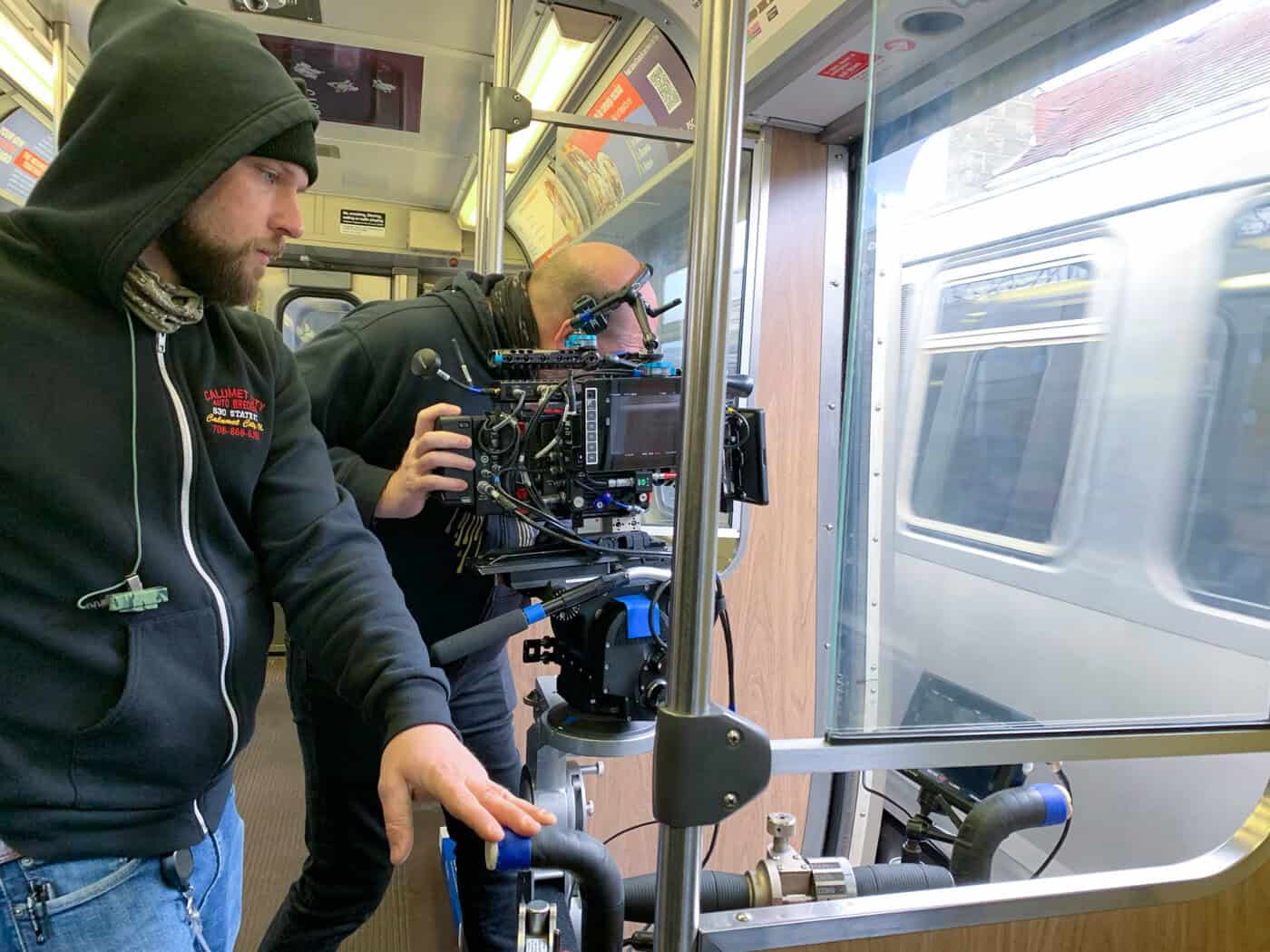
Dame: I think Ayo was really smart. She probably just naturally fell into this, but she very much had the Storer way of directing, which is that full trust to let us go. There were virtually no notes. Ayo’s just a very intelligent person; she does the New York Times crossword in pen. I remember that from Season 1. But she’s also funny, she’s a sweetheart, she’s such a talent. When we found out she was going to do an episode, we were all very excited and supportive.
Malouf: Insane film knowledge. She really knows her stuff. She was bringing in all kinds of references. “Have you ever seen this movie?” Or, “You know that one part in this?” She’s very, very good at communicating what she is looking for in the tone and feel, frame sizes, should it be a faster push or a slower push; she was way beyond her years in that regard. And Duccio and Ramy were the same. They did the homework, and at the end of the day, I think just being prepared really is half the battle. They were so ready to go. Nobody was making decisions on the fly outside of just tweaking what had already been kind of set up. It was refinement, it wasn’t finding it. That was always a really fun thing, because they put you in this position where now we can refine together. Now it’s collaborative, and now we’re going to make it the best it can be. I can’t say enough about those people. They were great to work with.
You know, so rarely do you wake up every day and say, “I can’t wait to get set. What are we going to do today?” I think at the end of the day, for me, that is a big part of it. And the other thing, honestly, is that it’s all Chicago locals. It’s really important to us, the fact that it’s a Chicago show with Chicago locals—a real love letter to the city, and an appreciation for the culinary scene in Chicago and the crews that work in kitchens and on sets. Being a bit of a smaller market, it means a lot to us that we were able to do it and that people have received it so well. We’re often kind of the forgotten city in the production world. So for us, it was very special and very important. We all came up together, we all worked on all these different crews together. I used to beg Chris [Storer] to hire me when I was an assistant. That’s the kind of relationships that we all had with each other. So, it was a very special thing for that reason. Chris being from Chicago, Drew being from Chicago, all the crew being from Chicago, a lot of the chefs being from Chicago, it was just one of those things where it really meant a lot to us to all be able to do that and shed a light on the city we love.
Dame: Every day is uniquely special. There’s just too many of them, all the restaurants that we shot at, all the wonderful local restaurants, the chefs, everything that they gave. Everybody just gives everything. There’s no question about the hospitality, that extra touch that goes into it. The parallel that Gary was talking about between the film business and the restaurant industry, sitting down with all those people, the list of names and the special moments are insane. Just standing there next to Grant Achatz while Davide Baroncini is right there. You’re shooting with Olivia Coleman, and she’s giving that gift, and she’s so present in it. That mushroom moment was magic. The last day we shot The Beef, Chris [Zucchero] stayed open with his crew and served all of us for however long we wanted. I think that went until two o’clock in the morning.
Malouf: He’s talking about Chris Zucchero, who owns Mr. Beef, which is the restaurant The Beef is based on. That’s Chris Storer and Courtney Storer’s childhood friend. And they’ve worked at Mr. Beef with him, and they’ve known each other forever. It is just this one big, happy family. That was a cool thing he did when he just opened the place up, it was midnight, and he was slinging beef like it was two in the afternoon.
Dame: I got one that runs all the way through. Drew Wehde is a coffee aficionado, so every morning my boss would make me a cortado. Gary, Drew, and I would be on the camera truck—most of the time it was just the three of us—and rarely were we talking about what the day’s work was or what the next scene was or any of that stuff. We were just talking with each other, savoring the coffee. I feel so lucky to be a part of a team like this that broke so many conventions, is truly a family, and that has all that trust and respect for each other. It’s just unbelievable. Those are the cornerstones for me, and it was given every day, every hour, every second.
Malouf: The hospitality of it all from everybody that we work with, and all the people whose spaces we worked in. The fact that Thomas Keller opened up the French Laundry garden to us, and the French Laundry kitchen to us, and we went to New York and shot with Daniel Boulud in his restaurant. First of all, Daniel Boulud is an incredible actor. I know he’s playing himself, but—incredible. Thomas Keller is incredible, and the fact that we got to go all the way to Copenhagen, René Redzepi opened up Noma to us. These places are cathedrals; they are the Meccas of the culinary world. For them to allow a bunch of weird film people from Chicago to come and raid their space, it speaks to the closeness of that community and the care that went into telling these stories. I’ll be grateful for the rest of my life that we were able to be a part of it.
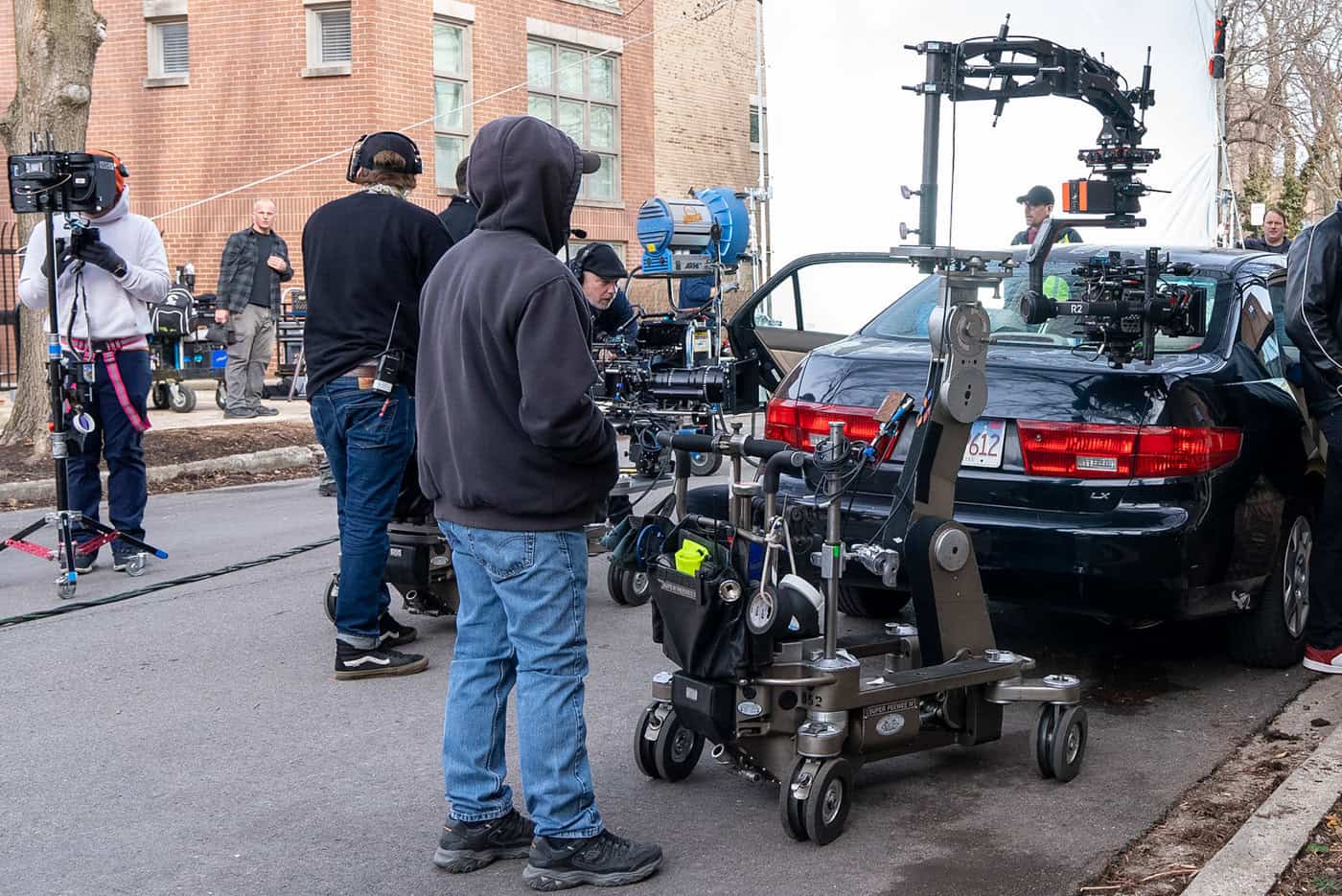
Camera Operator Fall 2024
Above Photo: Filming Edwin Lee Gibson in THE BEAR
Photos by Chuck Hodes/FX Networks
TECH ON SET
ARRI Mini LF Cameras
Panavision H Series Lenses
DJI Ronin 2 Stabilization System
RELATED CONTENT
Watch the Trailer for The Bear
Chris Dame
Learn more about Chris’ career and projects at IMDB.com
Gary Malouf
PHOTO GALLERY
Select Photo for Slideshow
SIGN UP FOR THE FREE
DIGITAL EDITION OF
CAMERA OPERATOR
Click Here
Gary Malouf
Gary Malouf was born and raised in the Chicagoland area. After studying film at DePaul University, he began his career in the non-union freelance world, while also working at a local camera rental house. Gary joined Local 600 shortly after and began working his way up the ranks of camera. His collaboration with cinematographer Andrew Wehde led to his first camera operating job on the Bo Burnham film Eighth Grade. Since then he has had the opportunity to work with many talented filmmakers. He is privileged to work with creator Christopher Storer, and the entire cast and crew of The Bear, for which he received his first SOC Camera Operator of the Year nomination in 2023. Most importantly, Gary would like to thank his beautiful wife Kelly for her love and support through years of long hours and endless movie quotes. His recent credits include The Bear, Justified: City Primeval, Map of Tiny Perfect Things, and The Chi.
Photo by Sandy Morris
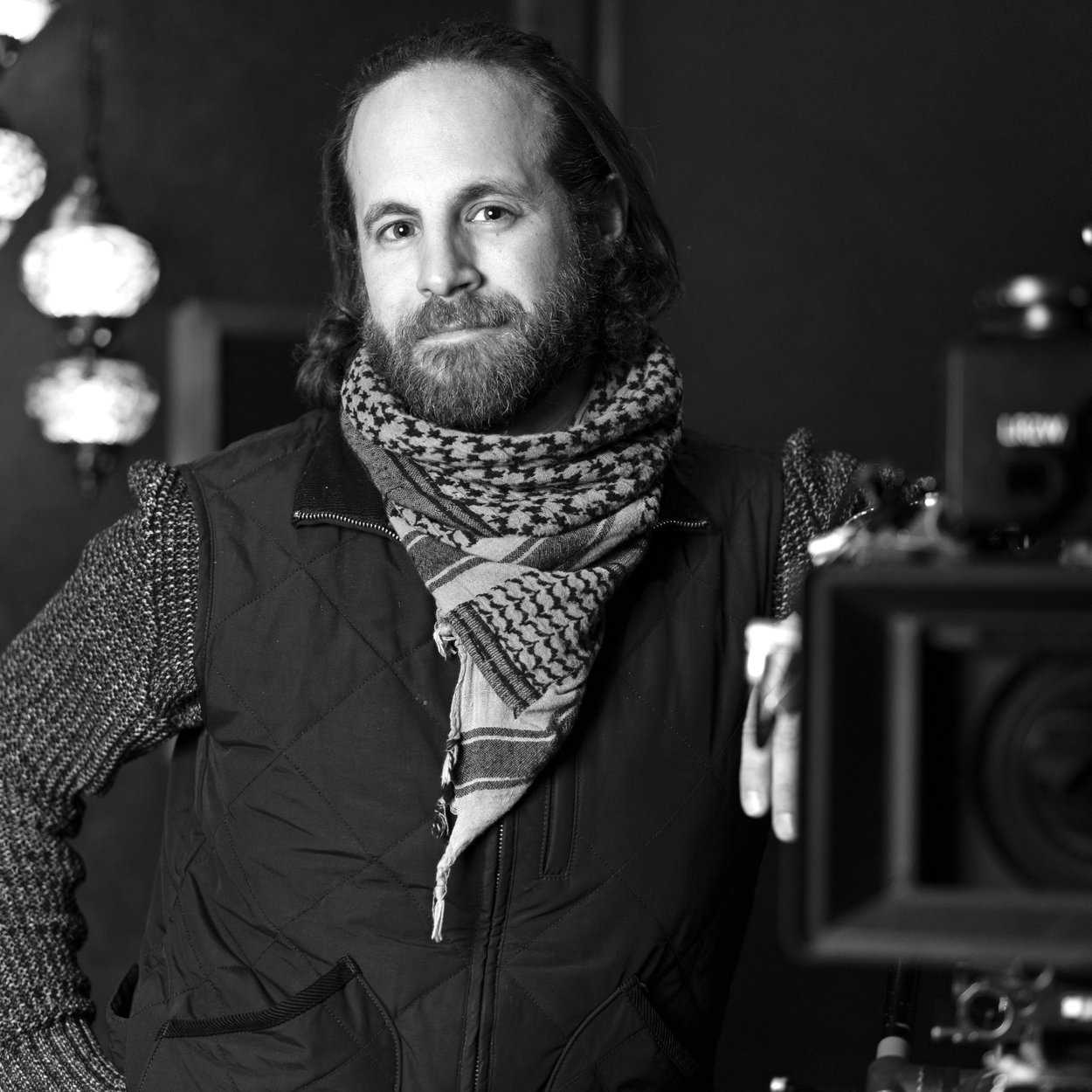
Chris Dame
Chris, a Chicago native, studied film and art history in college. After graduating, Chris worked at a camera rental house learning film equipment. He has been in the camera department for twenty-two years, and has been operating for the last seven years. In Chicago, Chris has worked on music videos, documentaries, television, and features. He has operated cranes, remote heads, arm cars, and drones.
Chris feels very fortunate to have worked on The Bear. He is thankful to Chris Storer, the creator, and Andrew Wehde, the cinematographer, who both granted him a tremendous amount of freedom. Chris wouldn’t be who he is today without his parents. He credits his mother, an artist, for his creative sense; and his father, a sociology teacher, for instilling a love for the collaborative process.
